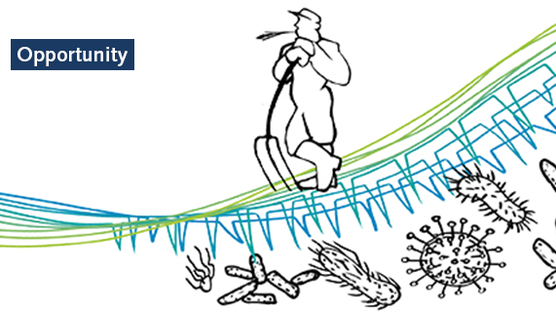
Published on May 1, 2021
Opportunities to achieve ideal animal protein production
Let’s start with the obvious, ideal animal protein production is what we all want. The question is… how do we define ‘ideal animal protein production’? Producing final products that satisfy as many targets as possible means that the hard work and passion of the producer is paid back in full. If we look at sustainable standards within chain economics, the way forward is to produce what people are willing to pay for.
Animal production at the heart of a multidimensional context
Animal production systems are not homogeneous throughout the world, as we are all aware. The challenge is therefore to create a sustainable food system that takes into account the disparities in production systems but also guarantees food security, good nutrition and sustainability for future generations worldwide. European livestock farming is not at the same technical level as in central Africa and does not have the same constraints as in Brazil or the Philippines. In addition, they are the specificities linked to the climates, civilizations, history and wealth of each country. However, the final objective is the same: the production of sustainable food resources. This vast program is supported by the Food and Agriculture Organization of the United Nations, which can only acknowledge the magnitude of the challenge facing the livestock production sector.
Ideal animal protein production has to take into account three main components: total economic sustainability, sustainable use of biodiversity and fostering buy-in for new solutions from both producers and consumers. Taking all three into account is vital, as the world is challenged to feed an ever growing population, while at the same time combating a climate crisis.
Total Economic Sustainability
As we look forward to the future, our company’s history has proven that total economic sustainability is a part of our DNA. For decades our genetic programs and business practices have worked hand in hand to ensure both long-term economic growth and benefits to society. Animal agriculture impacts everything from the environment to the people that care for animals and those that ultimately consume them.
According to the World Bank, agriculture accounts for 4% of global GDP and in some countries this can be as high as 25%. The World Bank also found that 70% of the world’s freshwater is used by agriculture alone. As the world’s population grows and demand for animal protein increases, figures show that by 2050 agricultural input will have to double from current production to meet the demand of an estimated 9 billion people.
As the first link in the animal protein chain, we play a critical role in ensuring total economic sustainability from production to consumer. It is for this reason that we have invested in world class animal welfare best practices, antibiotic stewardship, and corporate social responsibility programs around the world. Genetics is a long game, we understand that, which is why the long term success of all our stakeholders is what we strive for.

What level of sustainability is needed for biodiversity?
Biodiversity and sustainability go hand in hand, they are not mutually exclusive. Biodiversity on a grand scale represents the living natural resources that the planet has to offer. As the population of the world grows, this exerts ever more pressure on nature’s ability to meet the needs of humanity. The sustainable use of biodiversity is simple, use natural resources at a rate that it can naturally replenish itself.
Genetics is a key part to achieving this in animal agriculture through decreasing the feed and water inputs required by animals. This then means protein becomes more accessible to a growing population that requires that nutrition to live healthy and productive lives.
This issue is rising in importance as the UN FAO (Food & Agriculture Organization) reports that the loss of biodiversity around the world is threatening the global food supply. Less biodiversity means that plants and animals are more vulnerable to pests and disease.
Through improvement in genetics we have proven that by using X product along with biosecurity protocols, animal agriculture can work in harmony with the local environment and prevent the spread of disease instead of being a vector for it. Learn more about our biosecurity and breeding for diseases resistance here.
Future of food education efforts
Around the world, including in some of the more developed countries, myths about agriculture and food abound. The Washington Post featured a list of the 10 biggest myths in agriculture that show just how much work needs to be done in educating the public. Some of these included:
“Chemicals are the biggest threat to food safety” In reality, pathogens are the biggest threat to food safety, bacteria like salmonella pose a much greater risk to the consumer than chemicals that may find their way to the end product. This is why biosecurity measures taken from the start of the animal protein chain are so important, for everyone from producer to consumer.
“Farming is traditional and low tech” Agriculture is anything but low tech. From artificial intelligence to innovations in BlockChain and of course genetics, the way in which the world grows food is becoming increasingly sophisticated.
The future of food is full of possibilities. New innovations from genetics on one end to food science at the processing stage, are creating solutions to problems once thought unsolvable. The key to ensuring this is done properly, is by creating solutions that are both economically viable long term and sustainable. This will also make it more feasible to attain broad public support towards future innovations.
Consumers and producers are more conscious than ever to the impact their everyday choices have on the environment, their health and their local community. New innovations also have to be transparent and prioritize educating the public on the benefits from both a social, economic, environmental and in some cases cultural lens. Failing to do this can lead to low adoptions of great solutions simply based on a lack of knowledge from the public.
What are your thoughts on our economic sustainability stories?
If there is a topic you would like us to cover, please submit it via the button below.
You've read an opportunity article. Interested in the solution or challenge?
Do you want to explore all articles?



